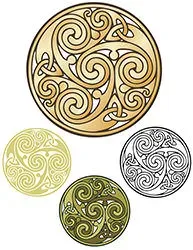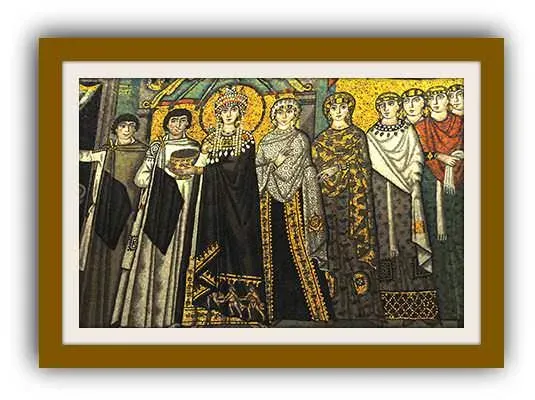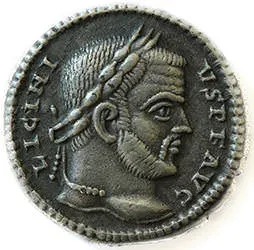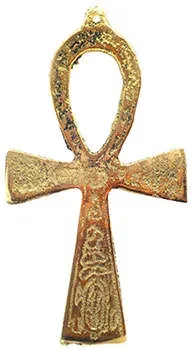 Ancient Rome extended its civilization across much of the known world, but by the end of the 4th century AD, the Roman Empire was in decline. Much of the political upheaval at the time was a religious struggle, and religion likewise influenced the production of culture. This includes, of course, the style of the jewelry produced, its distribution and how it was preserved for future generations to find out about. A brief explanation of the religious route from the Roman Empire up to the medieval era will help us understand the jewelry we have found dating from this period.
Ancient Rome extended its civilization across much of the known world, but by the end of the 4th century AD, the Roman Empire was in decline. Much of the political upheaval at the time was a religious struggle, and religion likewise influenced the production of culture. This includes, of course, the style of the jewelry produced, its distribution and how it was preserved for future generations to find out about. A brief explanation of the religious route from the Roman Empire up to the medieval era will help us understand the jewelry we have found dating from this period.
 Originally the Romans followed a rural animistic tradition, based heavily in Greek and Etruscan mythology. Families performed ceremonies to their ancestors, and the Roman emperor was honored as a god as well. Also in practice was Mithraism, a mystery religion supposedly founded by Zoroaster. Christianity began as a persecuted 1st century Jewish sect, but spread throughout the Greco-Roman world between 33 and 312 AD. The last two phases of government in ancient Rome were called the Dominate, established in 27 BCE and collapsing with the Western Empire in 476 AD; it was during the Dominate that Christianity began to flourish, and it was during the Dominate that the Roman Empire began its fall.
Originally the Romans followed a rural animistic tradition, based heavily in Greek and Etruscan mythology. Families performed ceremonies to their ancestors, and the Roman emperor was honored as a god as well. Also in practice was Mithraism, a mystery religion supposedly founded by Zoroaster. Christianity began as a persecuted 1st century Jewish sect, but spread throughout the Greco-Roman world between 33 and 312 AD. The last two phases of government in ancient Rome were called the Dominate, established in 27 BCE and collapsing with the Western Empire in 476 AD; it was during the Dominate that Christianity began to flourish, and it was during the Dominate that the Roman Empire began its fall.
 Emperor Galerius issued an edict permitting the practice of Christianity in 311, and in 313, Constantine I issued the Edict of Milan, announcing the toleration of the religion. Constantine would become, in fact, the first Christian emperor. In the waning days of the Roman Empire, emperor Theodosius enacted a law establishing Catholic Christianity as the official religion of the Roman Empire and ordering all others to be deemed heretical. All practices deemed "pagan", including Mithraism, ancestor worship, and the worship of emperors, were banned.
Emperor Galerius issued an edict permitting the practice of Christianity in 311, and in 313, Constantine I issued the Edict of Milan, announcing the toleration of the religion. Constantine would become, in fact, the first Christian emperor. In the waning days of the Roman Empire, emperor Theodosius enacted a law establishing Catholic Christianity as the official religion of the Roman Empire and ordering all others to be deemed heretical. All practices deemed "pagan", including Mithraism, ancestor worship, and the worship of emperors, were banned.
 One of the cultural changes that came with the widespread adoption of Christianity in the west was the adoption and development of Christian burial rites. Previously, of course, people were famously buried with much of their wealth, and it is from tombs that archaeologists learned much of what we know of pre-Christian jewelry. The body of Queen Pu-abi at Ur in Sumeria was covered with a robe of gold, silver,
One of the cultural changes that came with the widespread adoption of Christianity in the west was the adoption and development of Christian burial rites. Previously, of course, people were famously buried with much of their wealth, and it is from tombs that archaeologists learned much of what we know of pre-Christian jewelry. The body of Queen Pu-abi at Ur in Sumeria was covered with a robe of gold, silver, ![]() lapis lazuli, carnelian,
lapis lazuli, carnelian, ![]() agate and
agate and ![]() chalcedony beads, among other finery dating from the 3rd millennium BCE. Tutankhamen, the famous pharaoh of the 18th Egyptian dynasty, was buried with fabulous treasures in his pyramid, all of which revealed the degree of mastery attained by Egyptian goldsmiths. The handicraft of the sea-faring Minoans, Phoenician traders, the Greeks and pre-Christian Romans were all revealed through the plastic arts of painting and sculpture, but very importantly, through their burial practices as well.
chalcedony beads, among other finery dating from the 3rd millennium BCE. Tutankhamen, the famous pharaoh of the 18th Egyptian dynasty, was buried with fabulous treasures in his pyramid, all of which revealed the degree of mastery attained by Egyptian goldsmiths. The handicraft of the sea-faring Minoans, Phoenician traders, the Greeks and pre-Christian Romans were all revealed through the plastic arts of painting and sculpture, but very importantly, through their burial practices as well.
 As Christianity emerged and spread, the customs of many of its converts were incorporated into its burial habits: Romans cremated their dead, Jews buried their dead, and after the death, burial, and resurrection of Jesus, corpse burial became de rigueur among practitioners of the Christian faith. A common thread among Christian burials was a rejection of customs considered idolatrous: people were no longer buried with all their jewelry, and thus, beginning with the 8th century AD, almost the only important gold creations that have been preserved from this period were those in religious or royal holdings. We also still find out about jewels and fashion from mosaics and painted fragments of murals.
As Christianity emerged and spread, the customs of many of its converts were incorporated into its burial habits: Romans cremated their dead, Jews buried their dead, and after the death, burial, and resurrection of Jesus, corpse burial became de rigueur among practitioners of the Christian faith. A common thread among Christian burials was a rejection of customs considered idolatrous: people were no longer buried with all their jewelry, and thus, beginning with the 8th century AD, almost the only important gold creations that have been preserved from this period were those in religious or royal holdings. We also still find out about jewels and fashion from mosaics and painted fragments of murals.
 In 330 AD, the emperor Constantine established Constantinople in Byzantium as the capital of the Roman Empire: a city that contained churches within its city walls for the first time and had no pagan temples. During this era, the craftsmanship of ancient Greece and Rome, the symbolism of Christianity, and stylistic trends from the East came together in an amazing synthesis of decorative spirit. Jewelry was ornate. Quantities of pearls and precious stones passed through Constantinople, the highway of commerce between the East and Europe, and the workmen of the waning Empire were susceptible to the possibilities of magnificence. In the mosaics at Ravenna in Italy, one can see the gold robes of the Empress Theodora set with precious stones, the emeralds encircling her neck and shoulders, covering her neck, and festooning her breast. The Emperor Justinian beside her wears a diadem on his head and a massive mantle hung with lavish pendants.
In 330 AD, the emperor Constantine established Constantinople in Byzantium as the capital of the Roman Empire: a city that contained churches within its city walls for the first time and had no pagan temples. During this era, the craftsmanship of ancient Greece and Rome, the symbolism of Christianity, and stylistic trends from the East came together in an amazing synthesis of decorative spirit. Jewelry was ornate. Quantities of pearls and precious stones passed through Constantinople, the highway of commerce between the East and Europe, and the workmen of the waning Empire were susceptible to the possibilities of magnificence. In the mosaics at Ravenna in Italy, one can see the gold robes of the Empress Theodora set with precious stones, the emeralds encircling her neck and shoulders, covering her neck, and festooning her breast. The Emperor Justinian beside her wears a diadem on his head and a massive mantle hung with lavish pendants.
 The last Western Roman Emperor was deposed by the Germanic king Odoacer in 476 AD, although Constantinople itself survived until the Fourth Crusade in 1204. The Church, after the period of the decline of the Western Roman Empire, began a long period of missionary activity and expansion. As the boundaries of the Western Empire collapsed to Germanic tribes, Christianity spread into lands that had never even been Romanized. Some lands experienced a cultural shift not in terms of religion but definitely in terms of ethnic rule. All such passages of peoples forced shifts in culture and thereby shifts in jewelry trends.
The last Western Roman Emperor was deposed by the Germanic king Odoacer in 476 AD, although Constantinople itself survived until the Fourth Crusade in 1204. The Church, after the period of the decline of the Western Roman Empire, began a long period of missionary activity and expansion. As the boundaries of the Western Empire collapsed to Germanic tribes, Christianity spread into lands that had never even been Romanized. Some lands experienced a cultural shift not in terms of religion but definitely in terms of ethnic rule. All such passages of peoples forced shifts in culture and thereby shifts in jewelry trends.
 Britain, for example, was not a Christian country until around AD 600. Before Britain became a subject of Rome, their jewelry was comprised of bronze pins, brooches, torqued necklaces and bracelets. Throughout the period of Roman occupation, from about 43 AD to about 410 AD, British ornamentation reflected Italian designs, though with some variation. In Britain at this time, hairpins were very popular, and were made of bone, bronze, colored glass or jet. Enameling was a popular art under the Romans and it seems to have been the intention of its artisans to imitate colored stones. Britain then passed through what is commonly known as the Dark Ages, a period of which there is little archaeological evidence. During the Anglo-Saxon period after the fall of the Roman Empire, Celtic Christianity from the northwest and the Roman Catholic Church from the southeast spread into England, and the first Anglo-Saxon king was baptized in 601. The Teutonic invasion of England absolutely influenced English jewelry; it lost its Roman character and became impressed by German styles. Goldwork became more delicate and colors were blended in extremely harmonious ways. Individual workmanship was highly valued and pieces found from this period are rife with originality. Precious stones were sometimes used as amulets and coins of foreign origin were often used as pendants or on bracelets. One of the most distinctive trends was the setting of stones, mostly garnets, upon hatched gold foil between delicate gold cloisons. This was an intricate process of inlay and often took the shape of Christian crosses inside of circular forms. No Anglo-Saxon jewelry was enameled.
Britain, for example, was not a Christian country until around AD 600. Before Britain became a subject of Rome, their jewelry was comprised of bronze pins, brooches, torqued necklaces and bracelets. Throughout the period of Roman occupation, from about 43 AD to about 410 AD, British ornamentation reflected Italian designs, though with some variation. In Britain at this time, hairpins were very popular, and were made of bone, bronze, colored glass or jet. Enameling was a popular art under the Romans and it seems to have been the intention of its artisans to imitate colored stones. Britain then passed through what is commonly known as the Dark Ages, a period of which there is little archaeological evidence. During the Anglo-Saxon period after the fall of the Roman Empire, Celtic Christianity from the northwest and the Roman Catholic Church from the southeast spread into England, and the first Anglo-Saxon king was baptized in 601. The Teutonic invasion of England absolutely influenced English jewelry; it lost its Roman character and became impressed by German styles. Goldwork became more delicate and colors were blended in extremely harmonious ways. Individual workmanship was highly valued and pieces found from this period are rife with originality. Precious stones were sometimes used as amulets and coins of foreign origin were often used as pendants or on bracelets. One of the most distinctive trends was the setting of stones, mostly garnets, upon hatched gold foil between delicate gold cloisons. This was an intricate process of inlay and often took the shape of Christian crosses inside of circular forms. No Anglo-Saxon jewelry was enameled.
 Again, the Eastern Roman Empire remained intact, at least in terms of its administrative center in Constantinople, until the period of the Crusades, and so it is possible to trace a distinct cultural strand continuing to develop in Byzantium that paralleled and interacted with the Anglo-Saxon situation in the west. Figures and forms were banished from Byzantine representation in jewelry in the eighth century, an iconoclastic decision that forced goldsmiths into Italy, Germany, and Gaul, carrying with them the processes and designs of their art. The ban on representative images was lifted in the ninth century, but the period had already spawned a process of cross-germination of styles. Furthermore, the German Emperor Otho married the Byzantine Princess Theophano, politically connecting the German court and Constantinople.
Again, the Eastern Roman Empire remained intact, at least in terms of its administrative center in Constantinople, until the period of the Crusades, and so it is possible to trace a distinct cultural strand continuing to develop in Byzantium that paralleled and interacted with the Anglo-Saxon situation in the west. Figures and forms were banished from Byzantine representation in jewelry in the eighth century, an iconoclastic decision that forced goldsmiths into Italy, Germany, and Gaul, carrying with them the processes and designs of their art. The ban on representative images was lifted in the ninth century, but the period had already spawned a process of cross-germination of styles. Furthermore, the German Emperor Otho married the Byzantine Princess Theophano, politically connecting the German court and Constantinople.
 The vast majority of Byzantine ornaments seems to have consisted of gems sewn into garments, but the main difference between classical jewelry and Byzantine goldwork is that fine filigree and granulation were substituted for the coarse repousse and open-work found in classical late Roman jewelry. In general form, the new ornamentation retained the character of the old, but added to it fresh designs to suit religious shifts and ensuing trends in symbolism. Enamel and colored stones had previously been used with some reserve, but were now a chief artistic aspect of Byzantine jewelry. Precious stones predominated, but cloisonne enamel was also very popular. Wreaths were worn on the head, especially upon festive occasions such as weddings, when Christian brides and grooms wore crowns of gold, silver, green leaves, or flowers, which were afterwards returned to the church. Early Byzantine earrings resemble Roman patterns: some are formed like wire loops that hold a thimble-shaped cage of filigree, in the center of which is set a precious stone. From the sixth century onwards, the usual Byzantine earring is crescent-shaped gold repousse and open-worked in the form of a cross patee within a circle, supported on either side by peacocks.
The vast majority of Byzantine ornaments seems to have consisted of gems sewn into garments, but the main difference between classical jewelry and Byzantine goldwork is that fine filigree and granulation were substituted for the coarse repousse and open-work found in classical late Roman jewelry. In general form, the new ornamentation retained the character of the old, but added to it fresh designs to suit religious shifts and ensuing trends in symbolism. Enamel and colored stones had previously been used with some reserve, but were now a chief artistic aspect of Byzantine jewelry. Precious stones predominated, but cloisonne enamel was also very popular. Wreaths were worn on the head, especially upon festive occasions such as weddings, when Christian brides and grooms wore crowns of gold, silver, green leaves, or flowers, which were afterwards returned to the church. Early Byzantine earrings resemble Roman patterns: some are formed like wire loops that hold a thimble-shaped cage of filigree, in the center of which is set a precious stone. From the sixth century onwards, the usual Byzantine earring is crescent-shaped gold repousse and open-worked in the form of a cross patee within a circle, supported on either side by peacocks.
 The cross is naturally a favorite symbol among Christians, but it does not appear to have been commonly worn as jewelry anywhere until the fifth century. When it did begin to become popular, it was most often worn as a pendant, often as a pectoral, that species of pendant with which we are familiar from Egyptian times. Crosses were often ornamented with figures of Jesus, the Virgin Mary, angels or military saints. Some were hinged so as to form reliquaries or set inside larger frames. Crosses were also figured into the designs of circular brooches and finger rings. Rings were often offered as presents and were engraved with expressions of goodwill towards the recipient, whose name is often mentioned in the inscription. Gilded bronze was a common material for rings and silver appears to have been hardly ever employed in Byzantine jewelry making.
The cross is naturally a favorite symbol among Christians, but it does not appear to have been commonly worn as jewelry anywhere until the fifth century. When it did begin to become popular, it was most often worn as a pendant, often as a pectoral, that species of pendant with which we are familiar from Egyptian times. Crosses were often ornamented with figures of Jesus, the Virgin Mary, angels or military saints. Some were hinged so as to form reliquaries or set inside larger frames. Crosses were also figured into the designs of circular brooches and finger rings. Rings were often offered as presents and were engraved with expressions of goodwill towards the recipient, whose name is often mentioned in the inscription. Gilded bronze was a common material for rings and silver appears to have been hardly ever employed in Byzantine jewelry making.
 By 800 Western Europe was ruled entirely by Christian kings, but missionary activity continued in Eastern Europe until the end of the tenth century. Over time, the Church became divided into a Western branch, what is known as Catholicism, and an Eastern branch, which has become known as the Orthodox Church. The schism between these two branches is conventionally dated to 1054, but it was a gradual process that began with cultural differences between Eastern and Western Roman Empires and would culminate in the sack of Constantinople.
By 800 Western Europe was ruled entirely by Christian kings, but missionary activity continued in Eastern Europe until the end of the tenth century. Over time, the Church became divided into a Western branch, what is known as Catholicism, and an Eastern branch, which has become known as the Orthodox Church. The schism between these two branches is conventionally dated to 1054, but it was a gradual process that began with cultural differences between Eastern and Western Roman Empires and would culminate in the sack of Constantinople.